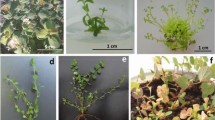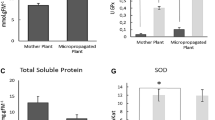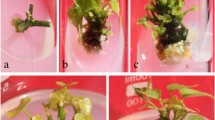Abstract
Satyrium nepalense is a rare and threatened medicinal orchid, populations of which in its native habitats are dwindling because of indiscriminate collections and habitat destruction, thus necessitating the development of methods for its in situ and ex situ conservation. Because of non-endospermous nature of the seeds and the immature embryos at seed dispersal stage, orchids cannot be seed-propagated as other plants. Micropropagation, using plant tissue culture techniques, offers an effective method for the multiplication of orchids. In this chapter, a five-step efficient reproducible protocol for large-scale in vitro multiplication of Satyrium nepalense is described. The first step involves asymbiotic germination of seeds isolated from immature green pods and cultured on Mitra’s medium (M) gelled with 0.8 % agar and supplemented with 2 % sucrose and 1 % peptone (hereafter referred to as basal medium, BM). On this medium, seeds start germinating after a week of culture. Protocorms developed from the seeds are sub-cultured on BM fortified with 4 μM kinetin (Kn) after 8 weeks, for shoot differentiation and multiplication. The shoots developed on Kn-supplemented medium are transferred to BM alone for their elongation for the same period. The elongated shoots are transferred to the rooting medium, comprising BM supplemented with 0.5 or 1.0 μM indole-3-butyric acid, for further 8 weeks. The regenerated plantlets are transferred to a potting mix of sand and vermiculite (1:1) for acclimatization. The tubers and leaves excised from both in vitro-developed plants and those from their native habitats are analyzed and compared for the contents and concentration of medicinally important phenolics using high-performance liquid chromatography (HPLC), details of which are provided in this chapter.
Access this chapter
Tax calculation will be finalised at checkout
Purchases are for personal use only
Similar content being viewed by others
References
Jalal JS, Kumar P, Pangtey YPS (2008) Ethnomedicinal orchids of Uttarakhand, Western Himalaya. Ethnobot Leaflets 12:1227–1230
Joshi G, Tewari LM, Lohani N, Upreti K, Jalal JS, Tewari G (2009) Diversity of orchids on Uttarakhand and their conservation strategy with special reference to their medicinal importance. Rep Opin 1:47–52
Bhatt D, Sharma P, Sharma L, Joshi GC (2012) Folk herbal remedies for skin care in Kumaun Himalaya. J Non-Timber Forest Prod 19:309–312
Thakur M, Dixit VK (2008) Ameliorative effect of fructo-oligosaccharide rich extract of Orchis latifolia Linn. on sexual dysfunction in hyperglycemic male rats. Sex Disabil 26:37–46
Panwar D, Ram K, Harish SNS (2012) In vitro propagation of Eulophia nuda Lindl., an endangered orchid. Sci Hortic 139:46–52
Mishra AP, Saklani S (2012) Satyrium nepalense: a rare medicinal orchid of Western Himalaya (India); phytochemical screening, antimicrobial evaluation and conservation studies. Indones J Pharm 23:162–170
Mahendran G, Bai VN (2009) Mass propagation of Satyrium nepalense D.Don.—A medicinal orchid via seed culture. Sci Hortic 119:203–207
Saklani S, Mishra AP, Parcha V, Chandra S (2011) Phytochemical and antibacterial evaluation of Satyrium nepalense and Saussurea simpsoniana, the threatened medicinal herbs of Uttarakhand. J Pharm Res 4:3866–3870
Medhi R, Chakrabarti S (2009) Traditional knowledge of NE people on conservation of wild orchids. Indian J Tradit Knowl 8:11–16
Kumari P, Singh BK, Joshi GC, Tiwari LM (2009) Veternary ethnomedicinal plants in Uttarakhand Himalayan region, India. Ethanobot Leaflets 13:1312–1327
Arditti J (2009) Micropropagation of orchids. Wiley, New York
Liu RH (2004) Potential synergy of phytochemicals in cancer prevention: mechanism of action. J Nutr 134:3479S–3485S
El Gharras H (2009) Polyphenols: food sources, properties and applications – a review. Int J Food Sci Technol 44:2512–2518
Merken HM, Beecher GR (2000) Measurement of food flavonoids by high-performance liquid chromatography: a review. J Agric Food Chem 48:577–599
Proestos C, Bakogiannis A, Psarianos C, Koutinas AA, Kanellaki M, Komaitis M (2005) High performance liquid chromatography analysis of phenolic substances in Greek wines. Food Control 16:319–323
Rice-Evans C, Miller N, Paganga G (1997) Antioxidant properties of phenolic compounds. Trends Plant Sci 2:152–159
Ruf J (1999) Wine and polyphenols related to platelet aggregation and atherothrombosis. Drugs Exp Clin Res 25:125–131
Tedesco I, Russo M, Russo P, Iacomino G, Russo GL, Carraturo A, Faruolo C, Moio L, Palumbo R (2000) Antioxidant effect of red wine polyphenols on red blood cells. J Nutr Biochem 11:114–119
Rauha JP, Remes S, Heinonen M, Hopia A, Kähkönen M, Kujala T, Pihlaja K, Vuorela H, Vuorela P (2000) Antimicrobial effects of Finnish plant extracts containing flavonoids and other phenolic compounds. Int J Food Microbiol 56:3–12
Jackson RS (1994) Wine science: principles and applications. Academic, San Diego, USA
Arimoto-Kobayashi S, Sugiyama C, Harada N, Takeuchi M, Takemura M, Hayatsu H (1999) Inhibitory effects of beer and other alcoholic beverages on mutagenesis and DNA adduct formation induced by several carcinogens. J Agric Food Chem 47:221–230
Malaveille C, Hautefeuille A, Pignatelli B, Talaska G, Vineis P, Bartsch H (1998) Antimutagenic dietary phenolics as antigenotoxic substances in urothelium of smokers. Mutat Res 402:219–224
Huang WY, Cai YZ, Zhang Y (2009) Natural phenolic compounds from medicinal herbs and dietary plants: potential use for cancer prevention. Nutr Cancer 62:1–20
Sahoo AK, Ansari AA (2007-2008) Notes on a threatened Orchid (Satyrium Sw.) in Sikkim Himalaya. ENVIS Quart Newslett 1: 4-5
Arditti J (1979) Aspects of the physiology of orchids. In: Woolhouse H (ed) Advances in botanical research, vol 7. Academic Press, London, pp 422–654
Dutta S, Chowdhury A, Bhattacharjee B, Nath PK, Dutta BK (2011) In vitro multiplication and protocorm development of Dendrobium aphyllum (Roxb.) CEC Fisher. Assam Univ J Sci Technol: Biol Environ Sci 7:57–62
Pradhan S, Pant B (2009) In vitro seed germination in Cymbidium elegans Lindl. and Dendrobium densiflorum Lindl. ex Wall. (Orchidaceae). Bot Orient J Plant Sci 6:100–102
Basker S, Bai VN (2010) In vitro propagation of an epiphytic and rare orchid Eria bambusifolia Lindl. Res Biotechnol 1:15–20
Knudson L (1922) Nonsymbiotic germination of orchid seeds. Bot Gaz 73:1–25
Ernst R (1982) Orchid seed germination and seedling culture - a manual: Paphiopedilum. Orchid Biol Rev Persp 2:350–353
Johnson TR, Stewart SL, Dutra D, Kane ME, Richardson L (2007) Asymbiotic and symbiotic seed germination of Eulophia alta (Orchidaceae) - preliminary evidence for the symbiotic culture advantage. Plant Cell Tiss Org Cult 90:313–323
Acknowledgements
The work was supported by a research project sanctioned to S.B.B. from the Indian Council Medical Research, New Delhi, and Research and Development grant from the University of Delhi. D.K.S. gratefully acknowledges the award of Junior and Senior Fellowships under the INSPIRE program of the Department of Science and Technology, Government of India.
Author information
Authors and Affiliations
Corresponding author
Editor information
Editors and Affiliations
Rights and permissions
Copyright information
© 2016 Springer Science+Business Media New York
About this protocol
Cite this protocol
Babbar, S.B., Singh, D.K. (2016). Protocols for In Vitro Mass Multiplication and Analysis of Medicinally Important Phenolics of a Salep Orchid, Satyrium nepalense D.Don (“Salam Mishri”). In: Jain, S. (eds) Protocols for In Vitro Cultures and Secondary Metabolite Analysis of Aromatic and Medicinal Plants, Second Edition. Methods in Molecular Biology, vol 1391. Humana Press, New York, NY. https://doi.org/10.1007/978-1-4939-3332-7_1
Download citation
DOI: https://doi.org/10.1007/978-1-4939-3332-7_1
Published:
Publisher Name: Humana Press, New York, NY
Print ISBN: 978-1-4939-3330-3
Online ISBN: 978-1-4939-3332-7
eBook Packages: Springer Protocols




